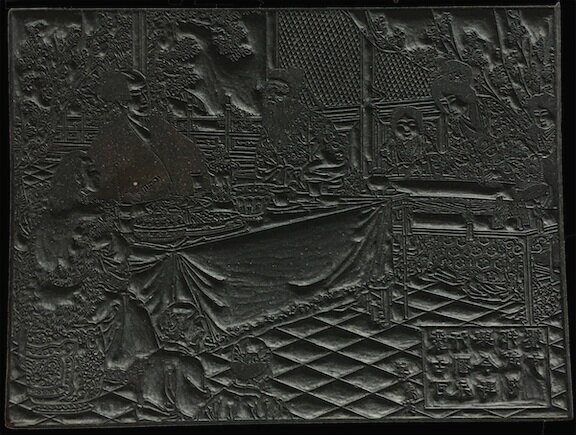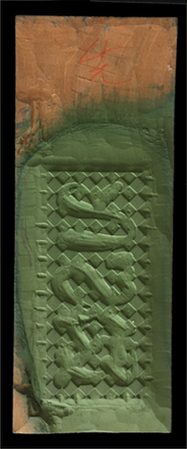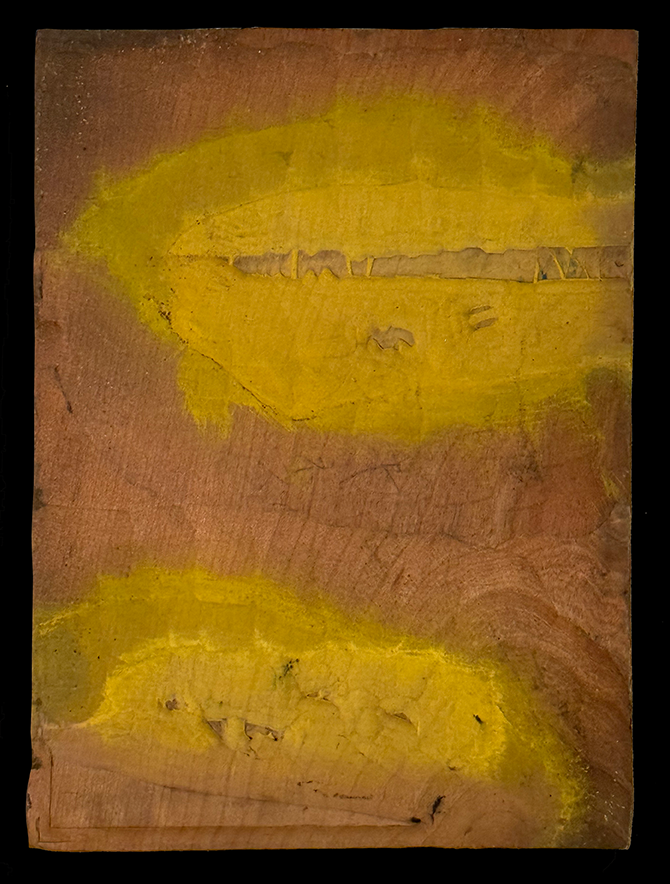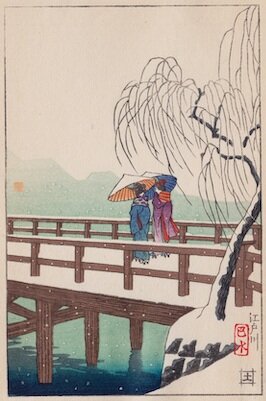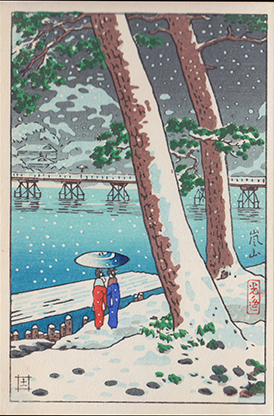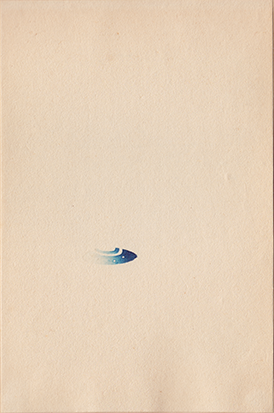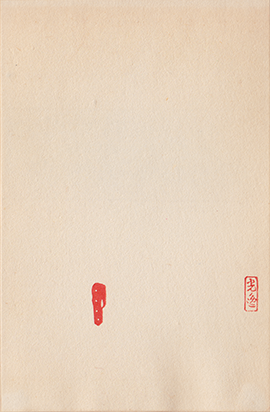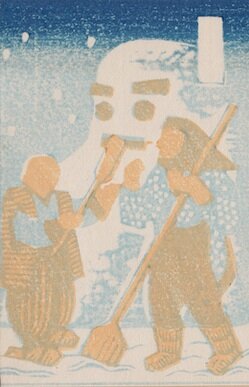Gallery 1: The Woodblock Printing Process
The technique of woodblock printing developed during the Edo period (1603-1868) of Japan. The traditional approach to printing involved a collaboration of publisher, artist, carver, and printer. The publisher employed the artist to produce images that were considered marketable. The artist created a preparatory sketch of a design and then made corrections and alterations as needed by adding additional pieces of paper. Then an assistant or block cutter would copy the image on paper with black ink which was then pasted to a block of cherry wood. The carver would then cut away all but the lines. From this carved block multiple images were printed in black, one for each intended color in the print. These were then pasted to additional blocks of wood and the blocks carved away to leave only the area for the intended color. The printers inked the blocks and sequentially added the colors by pressing the paper against the different blocks and rubbing from the back with a baren. This resulted in the gradual build up of a multicolor image.
Following the opening of Japan in 1858, Westerners became intrigued with Japanese woodblocks. As interest in woodblock prints waned in Japan, publishers began to print reproductions of traditional Ukiyo-e (Floating World) prints for this new market, including sets of miniature print series, postcards, and prints tipped into greeting cards.
This gallery includes items in the collection that illustrate aspects of the woodblock printing process for miniature Japanese woodblock prints.
Carved Woodblocks
This is a complete set of carved woodblocks for a miniaturized reproduction of a print depicting Kanagawa which is similar, but not identical, to the image of Kanagawa in the most famous of the many Fifty-Three Stations of the Tōkaidō series by Utagawa Hiroshige. The print was published by the Takamizawa Colour Print Studio in Tokyo. Separate blocks were carved for each color, although a block might be used for several colors if areas were sufficiently separate from each other. Colors could also be laid on top others to produce different shades or depth of color. The colors indicated for the blocks below are based on pigment that still remains on the blocks. The carvers used both sides of the block in order to use the cherry wood most economically. This set of blocks has been reworked, as evidenced by the inserted plugs for the title and signature (Hiroshige ga), the addition of the frame, and the addition of the kento marks which would have normally appeared directly on the key block.
The key block has the entire print design and was printed out in black. The attached blocks of wood on the bottom represent the kento marks (hikitsuke on the left, kagi on the right) used to register the paper during the multiple printing steps, These are carved directly into the larger blocks below
Yellow-Village, Ship; Black-Shading (bokashi) of Sky
Green-Boat and Shading (bokashi) of Ski; Purple-Shading on Horizon; Village-Tan
Yellow, Green, and Purple Shading (bokashi) of Water
The woodblock below is probably for a book page that would have been printed in black.
A Carved Block for the Printing of a Senjafuda
Carved Block for a Medicine Label
The set below is an example of combining two printing techniques. The block for the key print with all of the outlines for the image is composed of copper plates embedded in a woodblock. Presumably, this allowed for more printing of the key image with less wear than would have been expected if carved directly into wood. They key image was then printed and pasted onto other blocks which were carved and printed in the traditional manner. This is also an example of two miniaturizations of ukiyo-e prints being printed together. The top image is a miniaturization of Station 37, Akasaka, from The Kyoka Tokaido by Hiroshige. The lower image is a miniaturization of Station 43, Kuwana: Shichiri Crossing, from The Great Tokaido also by Hiroshige. The printing of two images at the same time also conserved cherry wood and allowed for more efficient printing. Part of the key image remains on the last block for red as this color was not used for the lower image.
Stages of printing of a design by Kawase Hasui
Eventually publishers began to offer woodblock printed albums that demonstrated the woodblock printing process itself. These albums often showed the process of reproducing images from the Edo period. However, publishers also produced books showing the production of then contemporary Shin Hanga (New Print) artists such as Kawase Hasui and Tsuchiya Koitsu.
The images below are from a 1954 print process book of the print Edogawa (The Edo River) by the Publisher Doi. Curiously, the introduction to the book states that the print is by Tsuchiya Koitsu but the image is one by Kawase Hasui. Doi produced woodblock process books of Koitsu images so this appears to be an example of a mismatched text page to a set of prints.
The book format presents an image of the the color being added at each stage of the printing process which is matched with how the images is developing. This gallery rearranges the images in two sections. The first section show just the image that would be produced if the various blocks were printed alone. This is followed by the prints that demonstrate the sequential development of the print as each color is added.
The prints below show how the image would progressively develop as each color was added.
Stages of printing of a design by Kawase Hasui
The following set is another example of the printing of an image by Kawase Hasui. The print is of Konjikido in Hiraizumi. The final print is unsealed but a version of this print has been observed affixed to a paper background which included the artist attribution. A sealed version can be viewed in Gallery 3E. It is likely that this version of the printing stages was a later edition than the sealed version. This set is remarkable for the fine gradations of ink applied over previously inked paper to add richness and depth to the final print.
Black Keyblock Outline
Light blue shading added.
Dark blue added.
Dark blue gradation in sky added.
Light blue background added.
Medium blue adding
Dark blue gradation added.
Dark brown shading added.
Gray added.
Blue-gray added.
Brown added
Blue-green to trees and coat added.l Text added. Final print.
The Printing Process for Tsuchiya Koitsu’s Arashiyama
Similar to the example above, these prints are from another accordian book published by Doi that illustrates the printing process of a print by Tsuchiya Koitsu. In this case the images are presented as they are in the book with each color block paired with its influence on the developing image.
Blue shading added to water for final image.
Cover. 10.6 x 15.7 cm
Dark blue to kimono
Introduction
Key block
Light gray added to trees, posts, and ground.
Light blue added to sky and ground.
Brown added to trees, bridge, and posts.
Blue shading added to umbrella.
Gray blues added to sky and ground.
Green added to trees and ground foliage.
Red added to kimono and artist’s seal.
The Printing process for Yoshida Hiroshi’s A Junk
The following woodblock prints are from The order of printing A Junk from Yoshida Hiroshi’s 1939 book, Japanese Woodblock Printing. These prints were also available as a separately sold set which is also in the collection and can be viewed here. Fifteen separate printing steps were involved in the print with many of the colors added with gradations in intensity. The numbered bars at the left and bottom margin of each print document the order of the steps and the colors added. The prints in the book differ from the separately printed set in that they lack numerical representation of the printing steps.
Both the Yoshida book and the printing set include a variation in which the blocks were used to print the image at night. Several prints in the collection reveal variations in colors for the same design, although the printing of A Junk at night adds an additional block for the lights and reflection in the water.
Examples of color variations of prints in the collection.
Black Kimono Version
Red Kimono Version
Sparrows - Grey background
Sparows -Gold background
The Process of Woodblock Printing as Illustrated by Katsuhira Tokushi
Katsuhira Tokushi was a Sōsaku-hanga (creative prints) artist who was also part of the folk art movement. As a Sōsaku-hanga artist, he cut the blacks and printed the woodblock prints himself in addition to creating the designs. He produced the following album of woodblock prints to illustrate the progressive development of a print. The image is of two children making a yukidaruma (snow daruma). The wooden paddles that the children are holding are yukibera and are referenced in the title which roughly translates to “Snow Spades”.
Katsuhira also designed and self-published this additional account of the woodblock printing technique from the perspective of a Sosaku Hanga artist.
Uncut sheets
Miniature Japanese woodblock prints are much smaller than the blocks used for the common Oban sized print (approximately 10 x 15 inches). For smaller sizes, it was more efficient to carve several designs into the same block and print the images together. These would then be cut apart for separate use. The uncut sheet below shows four seperate designs from one set of blocks. In this case, the block is already small in comparison to one for an Oban print.
The design for a miniature print could also be carved in multiples onto the same blocks. This is demonstrated in this uncut sheet of four miniatures of a design by Kawase Hasui which was published by Doi. In this case subtle variations in the image result from slight differences in carving. The image is similar to a larger print by Hasui titled Spring Snow at Kiyomizu Temple.
This is another example of an uncut sheet of similar designs that were printed together by the publisher Watanabe Shōzaburō. This work is often attributed to the artist Kawase Hasui, however it lacks his signature of seal. This example demonstrates that small and miniature prints issued at the same time can have minor variations. These are inevitable due to carving the image twice. Still the two prints are remarkably similar. This print is also unusual in that it was printed on silk that was first pasted to paper. Examples of the same image printed on paper can be found at the end of the Hasui gallery along with other works that have been speculated as being works of this artist.
This uncut sheet is of two prints by Ohara Shōson published by Watanabe. Unlike the individual prints of these images in the collection (Gallery 3F), these are unsealed. In addition, the Macaw on the right is white rather than red and the cherries are absent on the tree. Although it is possible that this is a variant print, it seems more likely that the printing process was incomplete and that a block for a deeper red meant for the seal, bird, and cherries, was never incorporated.
Another example of an uncut sheet of two small prints by an unidentified artist. In this case, the blocks have been cut without any margin between the two images. This attempt to conserve wood could result in a slim aspect of another image being visible to the right or left of a final print. This is unique to small print formats and can add to confusion when determining whether a backed postcard print woodblock or machine printed since the latter is often printed with no intervening margins prior to cutting and backing.
This uncut sheet once again demonstrates how the same small image could be carved into a block twice in order to conserve wood and make the printing process more efficient. The images abut each other rather than begin separated by a margin.
Tokuriki Tomikichira (1902-1999)
Unfinished Moon at Chushojima with elements of Chion-In in Black Gate Spring Scene on Right
This is an unusual uncompleted copy of Tokuriki Tomikichira’s Moon at Chushojima. It lacks the expected dark gray/black shadowing in the bridge and elsewhere as well as the artist seal which would appear in black at the lower right. Additionally, light gray imagery from the artist’s Chion-In in Black Gate Spring Scene appear in the margin at the right. This suggests that these two prints were initially carved and printed together but for some reason the publisher abandoned the second print, perhaps due to damage or excessive wear to one of the woodblocks. It is unclear why the printer did not add the final colors to complete the print.
Below are uncut sheets of a pochibukuro (money envelopes) set. These would have been cut apart and assembled into envelopes. These pochibukuro show the kabuki family actors Ichikawa Danjuro I through IX in roles that they they made famous in the Jūhachiban (eighteen best kabuki plays). The generations depicted are (left to right) Ichikawa Danjuro I; III; II on the top and Ichikawa Danjuro IV; VII; V on the bottom. Another sheet would have depicted Ichikawa Danjuro VI, VIII, and IX. In contrast to the other portraits, the depiction of Ichikawa Danjuro I is in the Torii syle.
These are examples of uncut sheets of woodblock printed matchbox labels. The left print has the name Nagao, likely the sponsor who commissioned them, The fan prints depict summer flowers. The name on these prints, Oda, also is likely to be that of the sponsor.










